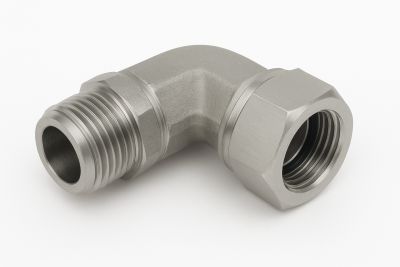Hydraulic systems are the lifeblood of many industries, from manufacturing plants to heavy construction sites. These systems rely on precision, safety, and efficiency to perform at their best. At the heart of every hydraulic system are the fittings, small but critical components that keep the entire setup secure and leak-free.
A reliable connection is vital, especially in high-pressure environments, where even the smallest leak can cause performance loss, downtime, or safety hazards. One such fitting that plays a key role in hydraulic setups is the 90-degree male O-ring bulkhead elbow. This specialized connector combines strength, leak prevention, and versatility, making it essential in demanding hydraulic applications.
What is a 90-Degree Male O-Ring Bulkhead Elbow?
A 90-degree male O-ring bulkhead elbow is a hydraulic fitting designed to connect two fluid lines securely while changing the flow direction by 90 degrees. Its design makes it particularly useful in compact or confined installations where straight fittings won’t work.
Key design elements include:
➡️ 90-degree angle – Redirects hydraulic flow efficiently in tight spaces
➡️ Male thread with O-ring seal – Provides a strong, leak-free connection
➡️ Bulkhead style – Allows the fitting to pass through a panel, housing, or enclosure, ensuring secure mounting
Compared to standard elbows, the bulkhead style fitting offers additional versatility by enabling connections through walls or structural surfaces. This makes it a practical solution for complex hydraulic layouts.
Key Features and Advantages
The 90-degree male O-ring bulkhead elbow offers several important benefits:
➡️ Leak prevention – The O-ring provides a secure seal that minimizes fluid loss even under high pressure
➡️ Space efficiency – The 90-degree bend is ideal for compact systems or tight installations
➡️ Strong bulkhead mounting – Securely locks through panels or housings for reliable positioning
➡️ Wide compatibility – Works with various hydraulic tubes and hoses across multiple systems
➡️ Reusability – Easy to disassemble and reinstall during maintenance without losing performance
Applications in Hydraulic Systems
These fittings are used across many industries where durability and precision matter:
➡️ Industrial machinery – Ensures reliable connections in assembly lines and automated systems
➡️ Automotive and heavy-duty vehicles – Used in braking, steering, and lifting systems
➡️ Agriculture and construction equipment – Supports hydraulics in tractors, excavators, and loaders
➡️ Marine and aerospace – Handles high-pressure demands in critical applications
➡️ Bulkhead installations – Perfect for systems requiring fluid passage through enclosures or walls
Material and Design Considerations
When choosing a bulkhead elbow, the material and design features are just as important as the size and fit:
➡️ Materials:
-
Carbon steel for strength in heavy-duty applications
-
Stainless steel for corrosion resistance in harsh or outdoor environments
-
Brass for moderate-duty or less demanding hydraulic systems
➡️ Corrosion resistance: Essential in marine, chemical, or outdoor settings
➡️ Pressure ratings: Must meet or exceed system operating pressures
➡️ Thread standards: Available in NPT, BSPP, JIC, ORFS, and other international thread types
➡️ O-ring material: Must be compatible with the hydraulic fluid (e.g., nitrile, Viton, EPDM)
Installation Best Practices
To ensure maximum performance and safety, proper installation is critical:
1. Prepare tubing and bulkhead surfaces – Clean thoroughly to remove debris or oil
2. Apply correct torque – Avoid leaks from under-tightening or thread damage from over-tightening
3. Check O-ring seating and lubrication – Ensure it is properly positioned and lightly lubricated
4. Use thread sealants only where needed – Avoid using them where O-ring seals are already sufficient
5. Inspect after installation – Look for signs of leaks, cracks, or misalignment
Benefits of Using a 90-Degree Male O-Ring Bulkhead Elbow
By integrating this fitting into your hydraulic system, you gain:
➡️ Leak-free reliability – Essential in high-pressure environments
➡️ Improved system performance and safety – Minimizing risks and downtime
➡️ Reduced maintenance costs – Thanks to easy disassembly and reusability
➡️ Versatility – Suitable for a wide range of industries and hydraulic layouts
How to Select the Right Bulkhead Elbow
When choosing a fitting for your system, consider the following:
➡️ Size and thread compatibility with existing tubing and hoses
➡️ Material selection based on environment and system demands
➡️ O-ring compatibility with hydraulic fluid types
➡️ Pressure rating compliance with your system requirements
➡️ Industry certifications such as SAE, ISO, or DIN for added reliability
Common Mistakes to Avoid
Even the best fitting can fail if installed incorrectly. Watch out for these pitfalls:
1. Over-tightening or cross-threading – Can damage threads and compromise sealing
2. Incorrect O-ring material – Leads to swelling, hardening, or premature failure
3. Skipping routine inspections – Small leaks can escalate into major problems
4. Mixing thread types – Incompatibility can cause weak or unsafe connections
Conclusion
The 90-degree male O-ring bulkhead elbow is more than just a connector, it’s a critical component that ensures leak-free performance, safety, and long-term durability in high-pressure hydraulic systems.
By selecting the right material, following best installation practices, and avoiding common mistakes, you can significantly improve your system’s efficiency and lifespan.
Need the right bulkhead elbow for your hydraulic application? Consult a trusted supplier or hydraulic specialist to find the perfect fit for your system.
Post time: Sep-22-2025


